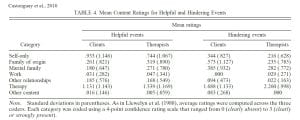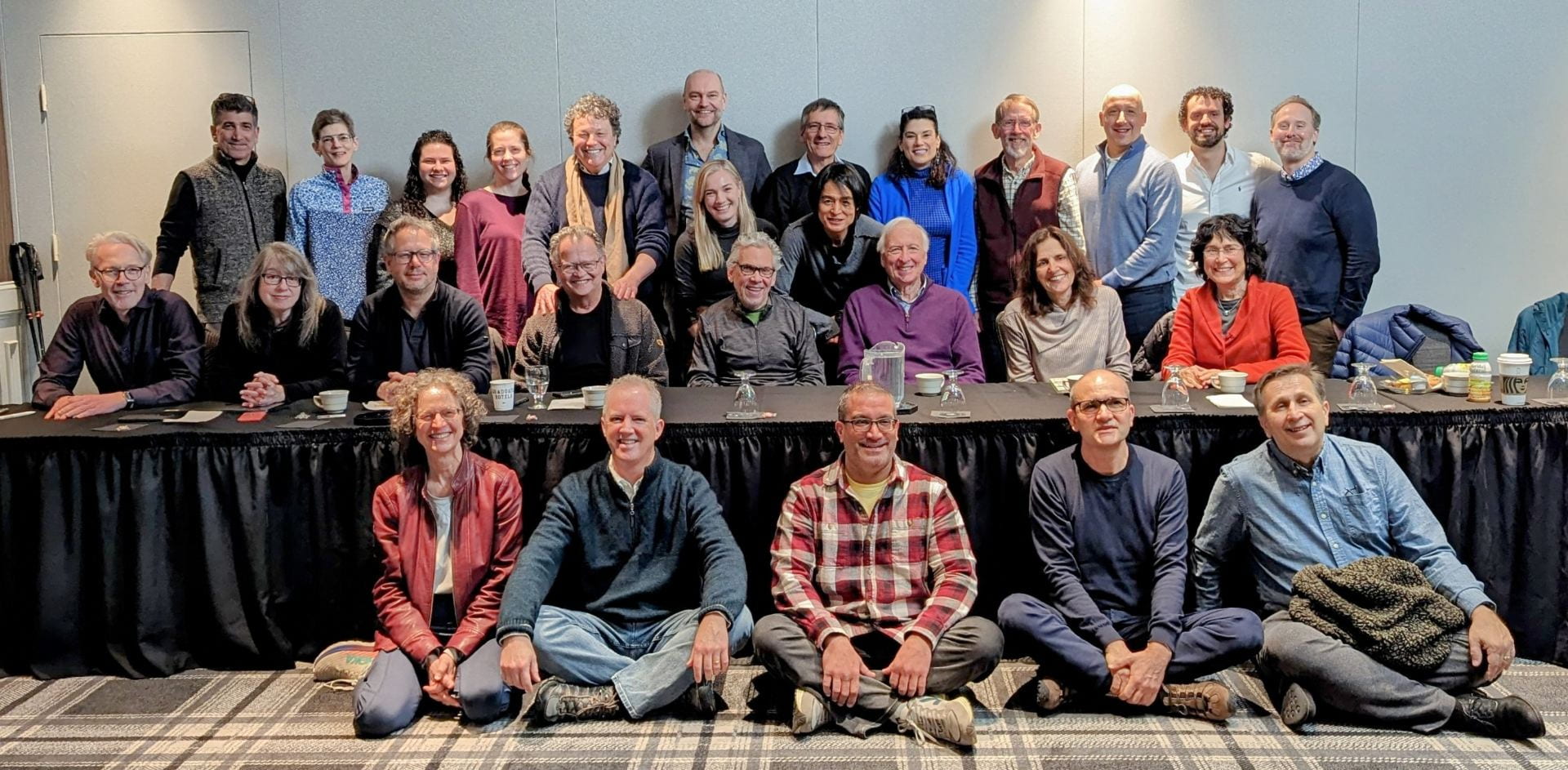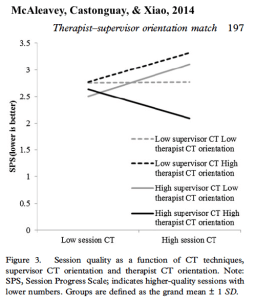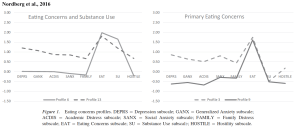Current Projects Overview
The research conducted in our lab is aimed at better understanding and improving psychotherapy. You will find in the page below a description of the primary focus of current projects that are going on in the lab, as well as the context for this research program. In addition, you will see a select list of recent publications with current and former graduate students as first authors and/or co-authors.
This research program reflects and interconnection and integration of six major themes. You can learn about these themes as well as the work that is going on within them below.
The overall research program and themes described below guide the development of research projects that members of the lab engage in. In addition to the citations provided, on the Students page you will find descriptions of graduate-led research projects currently underway that embody one or more of these themes!
Practice and Research
One of the most concerning issues in psychotherapy is the lack of connection between research and practice. Most clinicians are not substantially influenced by empirical findings in their practice, in part because many studies fail to address questions that are at the core of the clinical routine of full-time practitioners.
One way to integrate knowledge and expertise of researchers and clinicians is practice-oriented research (POR). In POR, practitioners, faculty members, and graduate students are fully collaborating in selecting topics to investigate, designing and implementing studies, as well as disseminating scientific results.
You will find here links to publications about different types of POR, as well as other initiatives and strategies to better the integration of practice and science: Castonguay et al., 2021; Castonguay, Constantino, & Xiao, 2019; Castonguay & Muran, 2015; Castonguay et al., 2015; Castonguay et al., 2013.
Center for Collegiate Mental Health (CCMH)
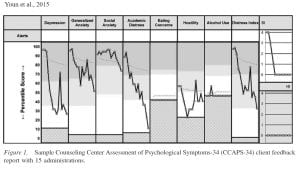 CCMH is a practice-network infrastructure that includes more than 500 university counseling centers using the same standardized assessment procedures. This allows us to conduct studies with several hundreds of thousands of clients, and many thousands of therapists.
CCMH is a practice-network infrastructure that includes more than 500 university counseling centers using the same standardized assessment procedures. This allows us to conduct studies with several hundreds of thousands of clients, and many thousands of therapists.
You will find here links to publications describing the CCMH infrastructure: McAleavey et al., 2015; Youn et al., 2015; Castonguay, Locke, & Hayes, 2011.
You will find here links to publications related to research that our lab has been involved with, within the CCMH infrastructure: Davis et al., 2023; Xiao et al., 2023; Pottschmidt et al., 2022; Carney et al., 2021; Kilcullen et al., 2021; Hayes et al., 2020; McAleavey et al., 2019; Youn et al., 2019; Xiao et al., 2017a; Xiao et al., 2017b; Hayes et al., 2016; Nordberg et al., 2016; Nordberg et al., 2013; Boswell et al., 2012; Hayes et al., 2011; McAleavey, Castonguay, & Locke, 2011; Nelson, Castonguay, & Locke, 2011.
Psychology Clinic Practice Research Network (Psychology Clinic PRN)
Our lab has played a central role in creating an infrastructure within the Department of Psychology clinic that allows for a simultaneous integration of the clinical and research needs of graduate students.
You will find here a link to a publication describing the Psychology Clinic PRN: Castonguay, Pincus, & McAleavey, 2015.
These publications relate to research that our lab has been conducting within the Clinic PRN infrastructure: McAleavy & Castonguay, 2014; McAleavy, Castonguay, & Xiao, 2014; Nordberg et al., 2014; Boswell, Castonguay, & Wasserman, 2010; Boswell, Castonguay, & Pincus, 2009.
Pennsylvania Psychological Practice Research Network (PPA PRN)
This PRN infrastructure involves practitioners in private practice with whom the lab has collaborated in conducting clinically relevant and scientifically rigorous studies in day-to-day clinical practice.
You will find here a link to a publication describing the PPA PRN infrastructure: Koerner & Castonguay, 2015.
You will find here links to publications related to research that our lab has been conducting within the PPA PRN infrastructure: Kilcullen et al., 2023; Castonguay et al., 2017; Castonguay et al., 2010a; Castonguay et al., 2010b; Ruiz et al., 2004.
Another way of fostering the integration of science and practice is to rely on the complementary expertise of researchers and clinicians to better understand how psychotherapy works.
You will find here a link to chapters from a book resulting from such a collaboration. The book presents a list of 38 empirically based principles of change and illustrates how expert clinicians apply these principles in their day-to-day practice. The book also engages researchers and clinicians in exchanges about several issues, including principles of change that are common to different orientations, those that are most helpful clinically, as well as those that clinicians believe should be the focus of future research. Castonguay, Constantino, & Beutler, 2019a; Castonguay, Constantino, & Beutler, 2019b.
Different Components of Change
Many researchers focus their attention on one particular aspect of therapy, such as the working alliance or the therapeutic techniques. Our lab is interested in investigating a wide variety of components and facets of the processes of change. This includes variables related to client and therapist characteristics, the therapeutic relationship, therapist interventions and actions, client’s engagement in therapy, as well as the interaction between these variables.
You will find here links to some publications related to these different processes or components of change: Constantino et al., 2023; Davis et al., 2023; King et al., 2020; Zack et al., 2015; McAleavey & Castonguay, 2014; McAleavey et al., 2014; Castonguay, 2013; Boswell, Castonguay, & Wasserman, 2010; Castonguay et al., 2010; Critchfield et al., 2007; Beutler, Castonguay, & Follette, 2006; Schut et al., 2005; Vocisano et al., 2004; Klein et al., 2003; Castonguay et al., 1998; Goldfried, Raue, & Castonguay, 1998; Goldfried et al., 1997; Arnow & Castonguay, 1996; Castonguay et al., 1996; Hayes, Castonguay, & Goldfried, 1996; Castonguay et al., 1995; Raue, Castonguay, & Goldfried, 1993; Kerr et al., 1992.
Psychotherapy Expertise
The Penn State Conferences on the Process of Change are a series of bi-annual meetings that Louis Castonguay and Clara Hill have been organizing since 2001. The first four sets of these conferences focused on insight, corrective experiences, therapist effects, and training, respectively. Each of these series of conferences has led to a book (Castonguay & Hill, 2007, 2012, 2017, 2023).
You will find here links for the introduction and conclusion chapters for these three books.
- Corrective Experiences: Corrective experience- Introduction; Corrective experience- Conclusion
- Insight: Insight- Introduction; Insight-Conclusion
- Therapist Effects: Therapist Effects: Introduction; Therapist Effects: Integration and Conclusions
- Training and supervision: Training and supervision – Introduction; Training and supervision – Integration and Conclusion
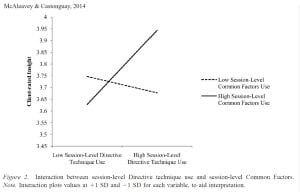 The conferences have involved a large contingent of highly respected and influential researchers from North America, as well as Europe (see below the participants of one of these conferences). They serve as opportunities to stimulate and exchange ideas, clarify or sharpen thoughts, generate new ways of thinking, and debate alternative views with the ultimate aim of building conceptual and empirical projects conducted by members between meetings. Each of the books that have resulted from these conferences showcase these innovative projects, and then present the consensus reached by the group in terms of defining, understanding, and investigating the specific theme focused on during the particular series of conferences.
The conferences have involved a large contingent of highly respected and influential researchers from North America, as well as Europe (see below the participants of one of these conferences). They serve as opportunities to stimulate and exchange ideas, clarify or sharpen thoughts, generate new ways of thinking, and debate alternative views with the ultimate aim of building conceptual and empirical projects conducted by members between meetings. Each of the books that have resulted from these conferences showcase these innovative projects, and then present the consensus reached by the group in terms of defining, understanding, and investigating the specific theme focused on during the particular series of conferences.
These conferences have guided and will continue to guide many projects that have been conducted in the lab.
You will find here a link of the chapters that we have contributed to each of the books derived from the conferences: Castonguay et al., 2012; Grosse Holtforth et al., 2006; Youn et al., 2017; Kilcullen et al., 2023.
You will also find here a link to some of the conceptual and empirical efforts that were generated by the conferences and that we conducted in the lab: McAleavey & Castonguay, 2014.
Back row (standing): Chris Muran, Sarah Knox, Judy Gerstenblith, Catherine Eubanks, Louis Castonguay, Frederick Falkenstrom, Franz Caspar, Michelle Newman, Bill Stiles, Michael Constantino, Juan Martín Gómez Penedo, James Boswell
Middle row (standing): Alice Coyne, Shigeru Iwakabe
Middle row (sitting): Martin Grosse Holtforth, Heidi Levitt, Christoph Flückiger, Jacques Barber, Dennis Kivlighan, Barry Farber, Orya Tishby, Hadas Wiseman
Front row (sitting): Clara Hill, Jeff Hayes, Jesse Owen, Miguel Gonçalves, Tim Anderson
Research and Training
Another interest of the lab is psychotherapy training. In particular, we are interested in identifying ways to improve training during and after graduate school, as well as to integrate research and training at different phases of psychotherapists’ careers.
You will find here links for publications related to an integrative perspective on psychotherapy training: Castonguay et al., 2023; Boswell et al., 2010; Boswell, Castonguay, & Pincus, 2009; Boswell & Castonguay, 2007; Castonguay, 2005; Castonguay, 2000.
You will find here a link to a publication on training implications that we have derived from research on deterioration in psychotherapy: Castonguay et al., 2010.
You will also find in the “Practice and Research” page a description of the practice research network (PRN) infrastructure that we have helped develop in order to foster a seamless integration of training and research needs of graduate students in the adult clinical program at Penn State. Also included in this page are publications presenting research conducted by the members of our lab within this PRN infrastructure and as part of their graduate career (e.g., masters thesis, dissertation).
Our current and future research on training are and will be guided by a series of conferences on training and supervision. This series is part of the Penn State Conferences on the Process of Change, which are described on the “Psychotherapy Expertise” page.
Different Theoretical Approaches
Most forms of psychotherapy can be associated with four major theoretical orientations: cognitive-behavioral, humanistic, psychodynamic, and systemic. All of them are important to our understanding and conducting of psychotherapy. We also believe that a fruitful way to capture the complexity of change and to improve our treatment of psychopathology is to consider contributions from each of these approaches.
Accordingly, the work and research conducted in our lab takes place in the context of a movement called “Psychotherapy Integration”. This movement involves four themes: theoretical orientation, systematic eclecticism, common factors, and assimilative integration.
Included here are links to publications about the integration movement in general (
Among the themes of integration, our lab is more strongly interested in common factors and assimilative integration.
Common Factors
Although each theory of psychotherapy emphasizes specific concepts (e.g., distorted thoughts, transference) and particular techniques (e.g., cognitive restructuring, analysis of defense), research is showing that change in therapy is explained in part by factors that are common to different forms of therapy. In this lab, we believe that identification of principles of change is a useful way to conceptualize and study these common factors. Among the principles of change that we focus most of our attention are the development and repair of alliance; the acquisition of a new perspective of self and others; and the fostering of corrective experiences.
Included here are links to theoretical and research publications address different types of common factors: Constantino et al., 2023; Davis et al., 2023; McAleavey & Castonguay, 2015; Castonguay et al., 2010; Castonguay et al., 2010; Constantino et al., 2010; Zack, Castonguay, & Boswell, 2007; Beutler, Castonguay, & Follette, 2006; Castonguay & Beutler, 2006; Castonguay, Constantino, & Grosse Holtforth, 2006; Beutler & Castonguay, 2005; Castonguay & Beutler, 2005; Castonguay et al., 2005; Castonguay & Grosse Holtforth, 2005; Grosse Holtforth & Castonguay, 2005; Klein et al., 2003; Castonguay, 2000; Castonguay, 1997; Castonguay et al., 1996; Castonguay, 1993; Raue, Castonguay, & Goldfried, 1993.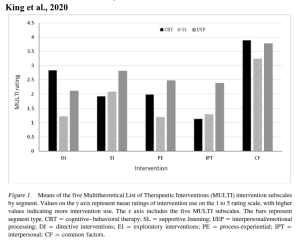
Assimilative Integration
One way to improve one particular form of therapy is to assimilate, within this approach, concepts and techniques that have been developed within other theoretical orientations.
You will find publications describing conceptual and empirical efforts to improve cognitive behavioral therapy and psychodynamic therapy within an assimilative integrative perspective included here: King et al., 2020; Castonguay, Newman, & Grosse Holftorth, 2019; Nelson & Castonguay, 2017; Newman et al., 2015; Boswell et al., 2011; Newman et al., 2011; Newman et al., 2008; Newman et al., 2004; Castonguay et al., 2004; Goldfried & Castonguay, 1993.
Psychotherapy and Psychopathology
One potential way to improve psychotherapy is to understand as much as possible the difficulties, needs, and vulnerabilities of clients and gear our interventions to address these issues. A strategy to achieve this goal is to learn from psychopathology research about the factors that are associated with particular diagnoses (e.g., depression, anxiety, personality disorder), such as symptomatology, clinical features, course, prevalence, comorbidity, prevalence, and etiology.
To foster the integration of psychopathology and psychotherapy, Louis Castonguay and Tom Oltmanns (2021) have edited a book aimed at two goals: (1) provide reviews of research on the nature and causes of psychological problems, and (2) derive clinical implications from this research that can be relevant to different approaches of psychotherapy. Each chapter of the book is written by teams of visible scholars, some of them recognized for their expertise in psychopathology, others for their research in psychotherapy, and many for their contributions to both of these areas of knowledge.
You will find here links for the introduction and conclusion chapters of this book.
You will find a link to a chapter of this book describing how the integration of psychopathology and psychotherapy can potentially improve our understanding and treatment of depression.
You will find here links for publications illustrating how findings from psychopathology and psychotherapy research can be combined to create a new and integrative treatment for generalized anxiety disorder (GAD). This integrative treatment appears to be particularly relevant for clients with GAD that have specific problems of attachment. Newman et al., 2015; Boswell et al., 2011; Newman et al., 2011; Newman et al., 2008; Castonguay et al., 2005; Newman et al., 2004.
Full references are available from Dr. Castonguay’s CV.
